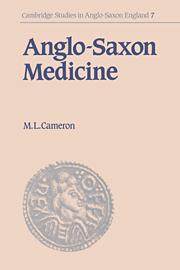Book contents
- Frontmatter
- Contents
- Preface
- Acknowledgements
- List of abbreviations
- 1 Introduction
- 2 Conditions for health and disease
- 3 Physician and patient
- 4 The earliest notices of Anglo-Saxon medical practice
- 5 Medical texts of the Anglo-Saxons
- 6 Compilations in Old English
- 7 Compilations in Latin
- 8 Latin works translated into Old English: Herbarium and Peri Didaxeon
- 9 Sources for Old English texts
- 10 Making a Leechbook
- 11 Materia medica
- 12 Rational medicine
- 13 Magical medicine
- 14 The humours and bloodletting
- 15 Surgery
- 16 Gynaecology and obstetrics
- 17 Conclusions
- Appendix 1 Quotations for ch. 10
- Appendix 2 Quotations for ch. 13
- Appendix 3 Quotations for ch. 14
- Appendix 4 Quotation for ch. 15
- Bibliography
- Index
2 - Conditions for health and disease
Published online by Cambridge University Press: 30 September 2009
- Frontmatter
- Contents
- Preface
- Acknowledgements
- List of abbreviations
- 1 Introduction
- 2 Conditions for health and disease
- 3 Physician and patient
- 4 The earliest notices of Anglo-Saxon medical practice
- 5 Medical texts of the Anglo-Saxons
- 6 Compilations in Old English
- 7 Compilations in Latin
- 8 Latin works translated into Old English: Herbarium and Peri Didaxeon
- 9 Sources for Old English texts
- 10 Making a Leechbook
- 11 Materia medica
- 12 Rational medicine
- 13 Magical medicine
- 14 The humours and bloodletting
- 15 Surgery
- 16 Gynaecology and obstetrics
- 17 Conclusions
- Appendix 1 Quotations for ch. 10
- Appendix 2 Quotations for ch. 13
- Appendix 3 Quotations for ch. 14
- Appendix 4 Quotation for ch. 15
- Bibliography
- Index
Summary
Before examining the medical records and their sources, we will find it helpful first to consider what we know (and may infer) about the conditions under which the Anglo-Saxons lived their daily lives, what were some of the ailments with which they were afflicted and how they treated them. The contents of grave sites reveal a fairly short life expectancy, a high infant mortality, women dying young, particularly in child-birth, and a fairly high incidence of bone and joint diseases, such as rheumatism, arthritis and rickets. The Anglo-Saxon population cannot have been particularly healthy. The conditions of life and diet help to establish a background for many of their illnesses.
Housing was relatively primitive, especially for a northern climate, and there is no doubt that we should have found their dwellings most uncomfortable. Archaeological evidence shows that most persons lived in small, damp, dark hovels, probably of one room, heated by a fire on a central hearth, with an opening in the roof through which smoke was supposed to escape. That the dwellings of the most affluent could not have been much more comfortable we learn from Bede's account of the council at the court of King Edwin of Northumbria in 627, concerning the adoption of the Christian faith, during which a councillor gave a beautiful description of the brevity of human life.
- Type
- Chapter
- Information
- Anglo-Saxon Medicine , pp. 5 - 18Publisher: Cambridge University PressPrint publication year: 1993

